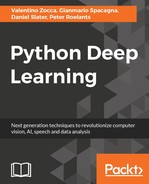In the previous chapter, we described several machine learning algorithms and we introduced different techniques to analyze data to make predictions. For example, we suggested how machines can use data of home selling prices to make predictions on the price for new houses. We described how large companies, such as Netflix, use machine learning techniques in order to suggest to users new movies they may like based on movies they have liked in the past, using a technique that is widely utilized in e-commerce by giants such as Amazon or Walmart. Most of these techniques, however, necessitate labeled data in order to make predictions on new data, and, in order to improve their performance, need humans to describe the data in terms of features that make sense.
Humans are able to quickly extrapolate patterns and infer rules without having the data cleaned and prepared for them. It would then be desirable if machines could learn to do the same. As we have discussed, Frank Rosenblatt invented the perceptron back in 1957, over 50 years ago. The perceptron is to modern deep neural nets what unicellular organisms are to complex multi-cellular lifeforms, and yet it is quite important to understand and become familiar with how an artificial neuron works to better understand and appreciate the complexity we can generate by grouping many neurons together on many different layers to create deep neural networks. Neural nets are an attempt to mimic the functioning of a human brain and its ability to abstract new rules through simple observations. Though we are still quite far from understanding how human brains organize and process information, we already have a good understanding of how single human neurons work. Artificial neural networks attempt to mimic the same functionality, trading chemical and electrical messaging for numerical values and functions. Much progress has been made in the last decade, after neural networks had become popular and then been forgotten at least twice before: such resurgence is due in part to having computers that are getting faster, the use of GPUs (Graphical Processing Units) versus the most traditional use of CPUs (Computing Processing Units), better algorithms and neural nets design, and increasingly large datasets, as we will see in this book.
In this chapter, we will formally introduce what neural networks are, we will thoroughly describe how a neuron works, and we will see how we can stack many layers to create and use deep feed-forward neural networks.
Neural networks have been around for many years, and they have gone through several periods during which they have fallen in and out of favor. However, in recent years, they have steadily gained ground over many other competing machine learning algorithms. The reason for this is that advanced neural net architecture has shown accuracy in many tasks that has far surpassed that of other algorithms. For example, in the field of image recognition, accuracy may be measured against a database of 16 million images named ImageNet.
Prior to the introduction of deep neural nets, accuracy had been improving at a slow rate, but after the introduction of deep neural networks, accuracy dropped from an error rate of 40% in 2010 to less than 7% in 2014, and this value is still falling. The human recognition rate is still lower, but only at about 5%. Given the success of deep neural networks, all entrants to the ImageNet competition in 2013 used some form of deep neural network. In addition, deep neural nets "learn" a representation of the data, that is, not only learn to recognize an object, but also learn what the important features that uniquely define the identified object are. By learning to automatically identify features, deep neural nets can be successfully used in unsupervised learning, by naturally classifying objects with similar features together, without the need for laborious human labeling. Similar advances have also been reached in other fields, such as signal processing. Deep learning and using deep neural networks is now ubiquitously used, for example, in Apple's Siri. When Google introduced a deep learning algorithm for its Android operating system, it achieved a 25% reduction in word recognition error. Another dataset used for image recognition is the MNIST dataset that comprises examples of digits written in different handwriting. The use of deep neural networks for digit recognition can now achieve an accuracy of 99.79%, comparable to a human's accuracy. In addition, deep neural network algorithms are the closest artificial example of how the human brain works. Despite the fact that they are still probably a much more simplified and elementary version of our brain, they contain more than any other algorithm, the seed of human intelligence, and the rest of this book will be dedicated to studying different neural networks and several examples of different applications of neural networks will be provided.
